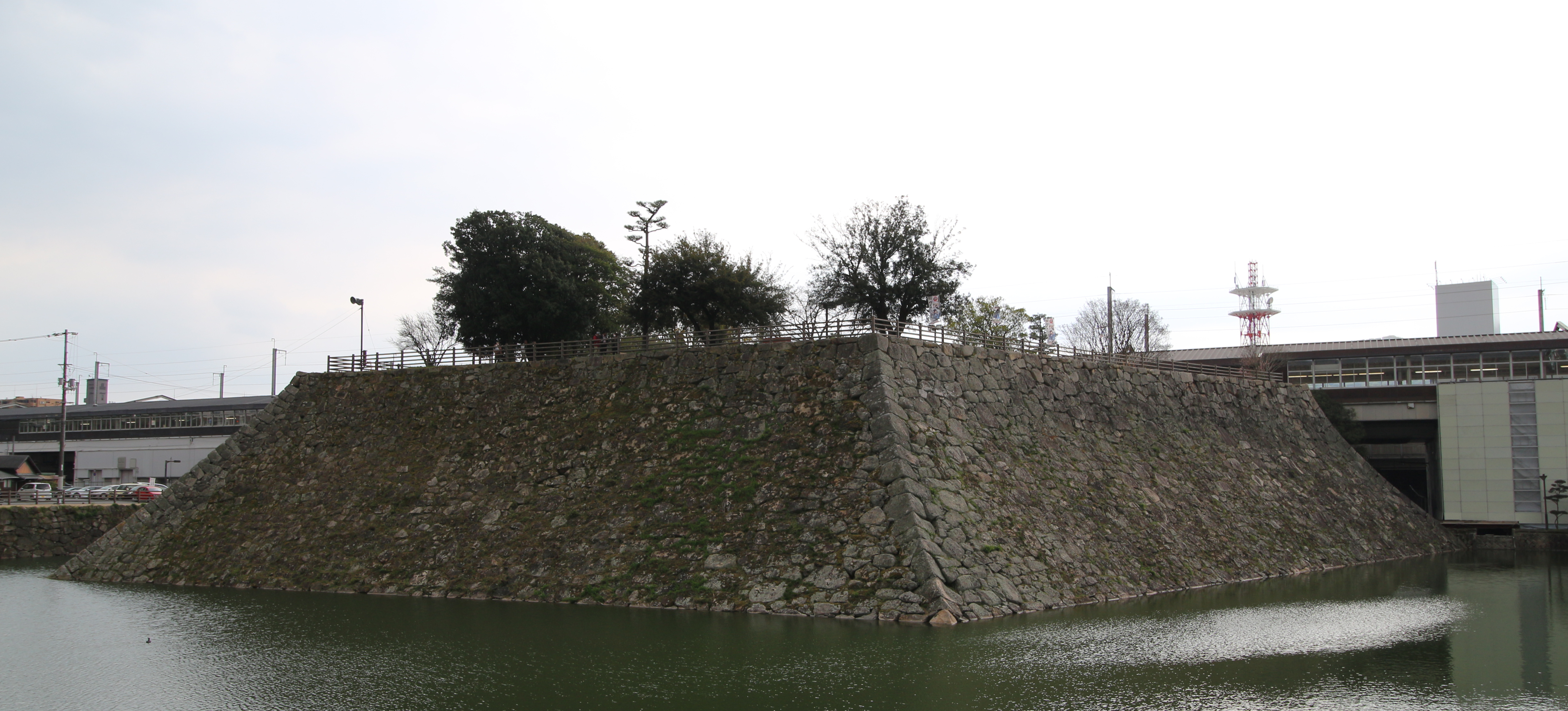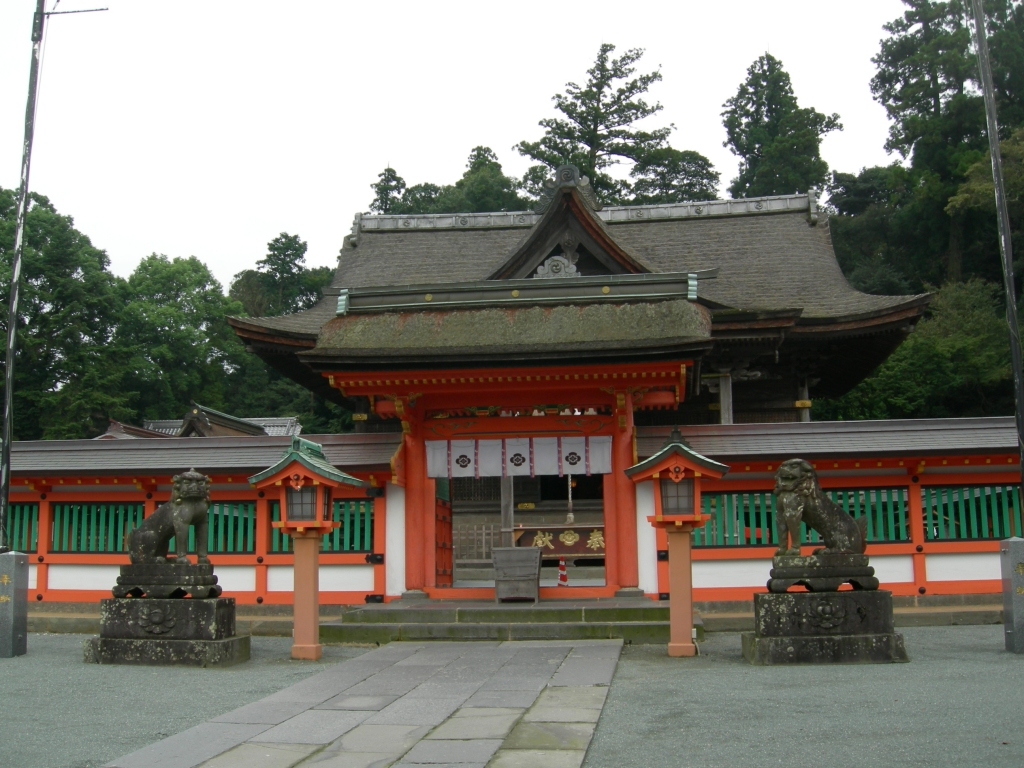|
Mihara Castle
, also known as Ukishiro Castle, is a ''hirashiro'' (castle on a plain) located in Mihara, Hiroshima Prefecture, Japan. History Mihara Castle was constructed in 1582 by Kobayakawa Takakage, who built this castle to protect the Mōri clan's coastline. Takakage constructed the castle on the coast, and connected it to two small islands, thus giving the castle its nickname- Ukishiro (floating castle). It had three baileys, thirty-two yagura, and fourteen gates. The ''tenshu'' (keep) was never constructed, though its foundation was completed, and is believed to be the largest ever constructed. After Toyotomi Hideyoshi conquered Kyūshū, Takakage was rewarded for being a loyal follower by being given land in Chikuzen, Chikugo, and Bizen. As a result, he moved to Najima Castle. However, he returned to reside at Mihara Castle following his 1595 retirement, and died there in 1597. During the Meiji Restoration, Mihara Castle avoided the destruction that most Japanese castles suffere ... [...More Info...] [...Related Items...] OR: [Wikipedia] [Google] [Baidu] |
Bizen Province
was a province of Japan on the Inland Sea side of Honshū, in what is today the southeastern part of Okayama Prefecture. It was sometimes called , with Bitchū and Bingo Provinces. Bizen borders Mimasaka, Harima, and Bitchū Provinces. Bizen's original center was in the modern city of Okayama. From an early time Bizen was one of Japan's main centers for sword smithing. Historical record In the 3rd month of the 6th year of the '' Wadō era'' (713), the land of Bizen''-no kuni'' was administratively separated from Mimasaka Province (美作国). In that same year, Empress Genmei's ''Daijō-kan'' continued to organize other cadastral changes in the provincial map of the Nara period. In ''Wadō'' 6, Tanba Province (丹波国) was sundered from Tango Province (丹後国); and Hyūga Province (日向国) was divided from Ōsumi Province (大隈国).Titsingh, Isaac. (1834) In ''Wadō'' 5 (712), Mutsu Province (陸奥国) had been severed from Dewa Province (出羽国). In the M ... [...More Info...] [...Related Items...] OR: [Wikipedia] [Google] [Baidu] |
Castles In Hiroshima Prefecture
A castle is a type of fortified A fortification is a military construction or building designed for the defense of territories in warfare, and is also used to establish rule in a region during peacetime. The term is derived from Latin ''fortis'' ("strong") and ''facere'' ... structure built during the Middle Ages predominantly by the nobility or royalty and by Military order (monastic society), military orders. Scholars debate the scope of the word ''castle'', but usually consider it to be the private fortified house, fortified residence of a lord or noble. This is distinct from a palace, which is not fortified; from a fortress, which was not always a residence for royalty or nobility; from a ''pleasance'' which was a walled-in residence for nobility, but not adequately fortified; and from a fortified settlement, which was a public defence – though there are many similarities among these types of construction. Use of the term has varied over time and has also been ... [...More Info...] [...Related Items...] OR: [Wikipedia] [Google] [Baidu] |
Niitakayama Castle
is the name for the earthly remains of a castle structure in Mihara, Hiroshima, Japan. Located on a 197.6 meter mountain. The site was designated a National Historic Site. History Niitakayama Castle was built in 1552 by Kobayakawa Takakage. Takakage moved Numata Kobayakawa clan's main base from Takayama Castle which located on the mountain across the numata river. In 1561, Mōri Motonari visited the castle and spent 10 days. In 1596, Takakage moved to Mihara Castle, stones and materials were transferred to Mihara castle at that time. The castle was listed as one of the Continued 100 Fine Castles of Japan in 2017. The castle is now only ruins, with some stone walls, moats and wells. See also *List of Historic Sites of Japan (Hiroshima) This list is of the Historic Sites of Japan located within the Prefecture of Hiroshima. National Historic Sites As of 1 July 2021, twenty-nine Sites have been designated as being of national significance (including two *Special Histor ... [...More Info...] [...Related Items...] OR: [Wikipedia] [Google] [Baidu] |
Mihara Station
is a railway station in Mihara, Hiroshima, Japan, operated by West Japan Railway Company (JR West). Lines Mihara Station is served by the following JR West lines. * Sanyo Shinkansen * Sanyo Main Line * Kure Line The is a railway line operated by West Japan Railway Company (JR West) within Hiroshima Prefecture in Japan. It begins at Mihara Station in Mihara and terminates at Kaitaichi Station in Kaita. It is one of the main lines of JR West. The secti ... History The station opened on 10 June 1894. External links JR West station information Railway stations in Hiroshima Prefecture Sanyō Main Line Sanyō Shinkansen Railway stations in Japan opened in 1894 {{Hiroshima-railstation-stub ... [...More Info...] [...Related Items...] OR: [Wikipedia] [Google] [Baidu] |
Stone Wall
Stone walls are a kind of masonry construction that has been used for thousands of years. The first stone walls were constructed by farmers and primitive people by piling loose field stones into a dry stone wall. Later, mortar and plaster were used, especially in the construction of city walls, castles, and other fortifications before and during the Middle Ages. These stone walls are spread throughout the world in different forms. One of the best example is the Cyclopean Wall in Rajgir, India. Materials Stone walls are usually made of local materials varying from limestone and flint to granite and sandstone. However, the quality of building stone varies greatly, both in its endurance to weathering, resistance to water penetration and in its ability to be worked into regular shapes before construction. Worked stone is usually known as ashlar, and is often used for corners in stone buildings. Granite is very resistant to weathering, while some limestones are very weak. Other ... [...More Info...] [...Related Items...] OR: [Wikipedia] [Google] [Baidu] |
Shinkansen
The , colloquially known in English as the bullet train, is a network of high-speed railway lines in Japan. Initially, it was built to connect distant Japanese regions with Tokyo, the capital, to aid economic growth and development. Beyond long-distance travel, some sections around the largest metropolitan areas are used as a commuter rail network. It is operated by five Japan Railways Group companies. Over the Shinkansen's 50-plus-year history, carrying over 10 billion passengers, there has been not a single passenger fatality or injury on board due to derailments or collisions. Starting with the Tokaido Shinkansen () in 1964, the network has expanded to currently consist of of lines with maximum speeds of , of Mini-Shinkansen lines with a maximum speed of , and of spur lines with Shinkansen services. The network presently links most major cities on the islands of Honshu and Kyushu, and Hakodate on northern island of Hokkaido, with an extension to Sapporo under constru ... [...More Info...] [...Related Items...] OR: [Wikipedia] [Google] [Baidu] |
Imperial Japanese Navy
The Imperial Japanese Navy (IJN; Kyūjitai: Shinjitai: ' 'Navy of the Greater Japanese Empire', or ''Nippon Kaigun'', 'Japanese Navy') was the navy of the Empire of Japan from 1868 to 1945, when it was dissolved following Japan's surrender in World War II. The Japan Maritime Self-Defense Force (JMSDF) was formed between 1952–1954 after the dissolution of the IJN. The Imperial Japanese Navy was the third largest navy in the world by 1920, behind the Royal Navy and the United States Navy (USN). It was supported by the Imperial Japanese Navy Air Service for aircraft and airstrike operation from the fleet. It was the primary opponent of the Western Allies in the Pacific War. The origins of the Imperial Japanese Navy go back to early interactions with nations on the Asian continent, beginning in the early medieval period and reaching a peak of activity during the 16th and 17th centuries at a time of cultural exchange with European powers during the Age of Discovery. After t ... [...More Info...] [...Related Items...] OR: [Wikipedia] [Google] [Baidu] |
Meiji Restoration
The , referred to at the time as the , and also known as the Meiji Renovation, Revolution, Regeneration, Reform, or Renewal, was a political event that restored practical imperial rule to Japan in 1868 under Emperor Meiji. Although there were ruling emperors before the Meiji Restoration, the events restored practical abilities and consolidated the political system under the Emperor of Japan. The goals of the restored government were expressed by the new emperor in the Charter Oath. The Restoration led to enormous changes in Japan's political and social structure and spanned both the late Edo period (often called the Bakumatsu) and the beginning of the Meiji era, during which time Japan rapidly Industrialisation, industrialized and adopted Western culture, Western ideas and production methods. Foreign influence The Japanese knew they were behind the Western powers when US Commodore (United States), Commodore Matthew C. Perry came to Japan in 1853 in Black Ships, large warshi ... [...More Info...] [...Related Items...] OR: [Wikipedia] [Google] [Baidu] |
Najima Castle
is a hilltop castle, located in Fukuoka City, Fukuoka Prefecture, Japan. Today, only its ruins still stand. History Najima Castle was located on a peninsula projecting into Hakata Bay on the north of the estuary of the Tatara River. The castle fundamentally consisted of the hon-maru or primary kuruwa, the ni-no-maru or secondary kuruwa, and the san-no-maru or tertiary kuruwa, respectively ranging from west to east, and extending for over 900 meters or 2953 ft. The hon-maru, presumably the highest place in the castle, is now about 25 meters or 82 ft. above sea level.福岡市埋蔵文化財調査報告書第318集『名島城跡I』(福岡市教育委員会、1993年)第2図/Fukuoka City Excavation Report Vol.318 "The site of Najima Castle I", Fukuoka City Board of Education, Fig.2 The castle was built by Kobayakawa Takakage, an illustrious Japanese general, in the late 16th century. However, it turned out to be undesirable as the administrative center of the han o ... [...More Info...] [...Related Items...] OR: [Wikipedia] [Google] [Baidu] |
Chikugo Province
is the name of a former province of Japan in the area that is today the southern part of Fukuoka Prefecture on Kyūshū. It was sometimes called or , with Chikuzen Province. Chikugo was bordered by Hizen, Chikuzen, Bungo, and Higo Provinces. History The ancient capital of the province was located near the modern city of Kurume, Fukuoka. During the Edo period the province was divided into two fiefs: the Tachibana clan held the southern fief at Yanagawa, and the Arima clan held the northern fief at Kurume. During_the_Meiji_era.html" ;"title="DF 6-7 of 80/nowiki>">DF ... in Sengoku period. --> During the Meiji era">DF 6-7 of 80/nowiki>">DF ... in Sengoku period. --> During the Meiji era, the provinces of Japan were converted into prefectures. Maps of Japan and Chikugo Province were reformed in the 1870s. Timeline * 1359 (''Enbun 4''): Battle of Chikugo River (''Chikugogawa''), Ashikaga gain a military victory. * 1361 (''Enbun 6'') : Imperial forces led by Kikuch ... [...More Info...] [...Related Items...] OR: [Wikipedia] [Google] [Baidu] |
Japanese Castle
are fortresses constructed primarily of wood and stone. They evolved from the wooden stockades of earlier centuries, and came into their best-known form in the 16th century. Castles in Japan were built to guard important or strategic sites, such as ports, river crossings, or crossroads, and almost always incorporated the landscape into their defenses. Though they were built to last and used more stone in their construction than most Japanese buildings, castles were still constructed primarily of wood, and many were destroyed over the years. This was especially true during the Sengoku period (1467–1603), when many of these castles were first built. However, many were rebuilt, either later in the Sengoku period, in the Edo period (1603–1867) that followed, or more recently, as national heritage sites or museums. Today there are more than one hundred castles extant, or partially extant, in Japan; it is estimated that once there were five thousand. Some castles, such as the ones a ... [...More Info...] [...Related Items...] OR: [Wikipedia] [Google] [Baidu] |







